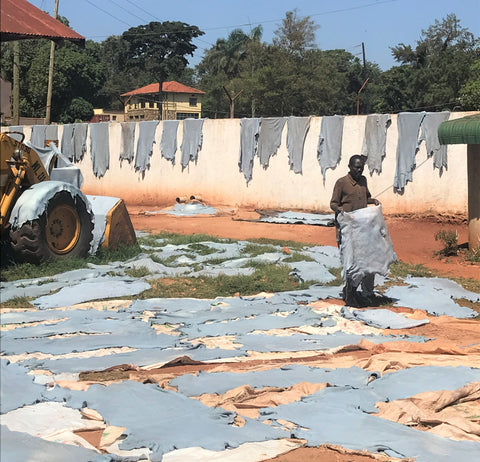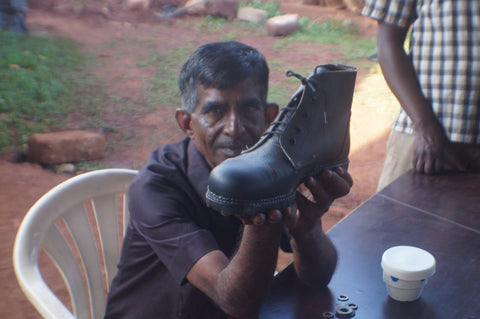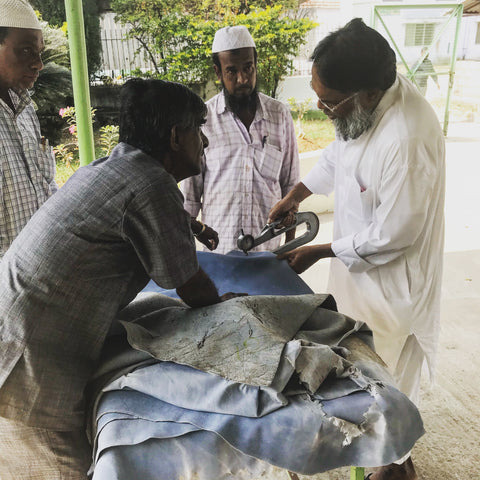How To End Poverty
“There is no way that masses of people are going to get employed, and you’re going to see rising wages without industrial development.” - Professor Chris Blattman, University of Chicago
"Trying to stop factories from setting up in poor countries would be a great way to keep people poor." - Vox, Zack Beauchamp
___________________________________________________
There are currently 856 million people in Sub Saharan Africa where the poverty rate is 41%. Globally, there has been tremendous progress in reducing poverty but Sub Saharan Africa is a tragic outlier.
The major difference in the reduction of poverty between Asia and Sub Saharan Africa has been the rise of manufacturing in one (Asia) and the reduction in the other (Africa). China, for instance, was able to grow it's share of manufacturing output from 3% in 1990 to almost 25% today. In the process China has lifted more than 700 million people out of extreme poverty.
If we are rooted in the belief that we are all created equal, do we believe the same prosperity can come to Africa?
The leather industry represents one of the best opportunities to create quality jobs in East Africa. Africa already represents 4% of global leather exports but it is emblematic of the difficulties in establishing higher value manufacturing in the region. Uganda and Rwanda boast large stocks of quality hides as well as large herds in sheep and goat. In Uganda, 80% of hides come from small scale herders and leather goods manufacturing is very labor intensive.
At our factory in Uganda we constantly receive delegations from the Ugandan government, the World Bank, and leading academics because the potential of the industry can impact millions.

Uganda President Museveni visits the factory in 2011
The challenge is that turning a hide into finished leather is very expensive. Large machinery is required along with skilled technicians who are able to master the formula. Additionally, finished leather cannot be altered. This means it is very risky to produce finished leather before a buyer has demand. For this reason finished leather is done where the manufacturing of finished goods takes place. That is not in Africa.
In Uganda there are 8 tanneries. Each one makes semi-finished leather for export which is only 15% of the potential value of a finished product. What small manufacturing exists in Uganda has to import finished leather at high prices and have to compete with cheap imports from Asia. Despite the potential, the industry is stuck and Ugandans continue to languish in poverty.
How can Uganda reach its potential?
Often in Africa we see large scale investments with foreign capital and government favors. While there are instances of success, this model does not create broad based growth. The value chain needs to be built out in a pragmatic and incremental way. In this way the average Ugandan with an idea and a dream can begin to execute on it.
Our local partner in Uganda started his factory after leaving a large tannery because they were not interested in taking the risk of building out the leather value chain. With 3 workers and making 5 shoes a day the factory has now grown to 70 workers making 3,000 shoes a month and a tannery capable of producing 150,000 SqFt of semi-finished leather per month. Despite this success, we have a long way to go.
Leather Security Shoe Made in Uganda
We are not capable of providing the local market with finished leather and the quality of manufacturing is not where it needs to be but the building blocks are there. In the 4 years since we met our local partner we have wasted time, effort, and money trying to create a quality product at a competitive price out of Africa. Therefore we had to get creative.
At Venture we source hides from Uganda and process them to a semi-finished state (wet blue). The hides are then exported to India where we work with manufacturers to finish the leather and manufacture our bags. Our bags are then sold to customers around the world under the model where 100% of the profit is invested back into Uganda. We cover our costs then create a venture capital (hence our name) to build out the leather value chain in Uganda.
First semi-finished leather (wet blue) samples delivered to India in Nov 2017
Current Operations
Today we are exporting containers of semi-finished leather (wet blue) to India. We have regional offices in Uganda for a constant supply of hides as well as contacts with suppliers in Rwanda with excellent quality raw material.

Wet blue leather drying. Added 25 workers in the past year at our tannery.
In the coming months we will be importing a container of materials and chemicals from India so that the quality of leather produced in our tannery is increased while our cost of production will be reduced. The hides that aren't good enough to export are made into finished leather for the security shoes that are sold throughout East Africa.
Each container we sell increases our working capital to invest in training and eventually building the capacity of our tannery. We have already presented plans to local government officials about building a crust leather unit which is the next stage before making finished leather. This increases the value addition but is done so incrementally and buyer of this leather already in place due to our wet blue trading.
Beginning in 2019 we brought over a technician from India who is working full time to train workers in our tannery. We have partnerships with 3 universities in Uganda who have students interning in our factory and have engaged in initial discussions with the government to set up a leather training institute.
For Venture, we will bring our manufacturing to Uganda as soon as we can assure quality and affordability out of Uganda. Our plan is to soon import leather from India to begin manufacturing our bags for the Ugandan market first and then for export. We have identified technicians from India who are ready to come train our work force.
The World Needs Our Solution
Kate Spade set up a factory in Rwanda and employs over 150 workers making excellent quality bags. These are quality jobs and Kate Spade should be applauded for their efforts. Yet the impact is limited. Every input used in the operation is imported. Leather, zippers, thread, etc are all imported from China.
Rwandans are no closer to being able to launch their own leather factories. Kate Spade's operation is anomaly. An anomaly that only large amounts of foreign capital can produce.
At Venture our incremental growth will create ripple effects throughout Uganda and the region. Quality materials will be available and affordable. Workers will be trained for local and export production. And perhaps most importantly, Ugandans will have tangible proof that their dreams for a better future can be realized. Our commitment is not to just be a success ourselves but to reduce the barriers that stifle the potential of others.




